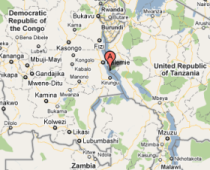The highly destructive invasive, Mimosa diplotricha is in Bujumbura!

What is an invasive species?
An invasive species is an animal or plant which is introduced into a new area where it does not occur naturally. If the introduction occurs without the accompaniment of its pests and diseases that keep the species in check (under control) in its natural range and if it is able to survive, establish and spread thus causing damage to biodiversity, peoples’ livelihoods or development, it is called “invasive”.
Definition of Mimosa Diplotricha
Mimosa Diplotricha, commonly known as the “creeping sensitive plant”, is a spiny shrub or climber that prefers to grow in damp places, but can survive in many situations. It originally comes from Brazil and its introduction into Africa is continuing to be felt as it spreads across the continent. This plant has long, square-sided stems that scramble or climb on other plants and have many small spines along their length . It has many small green pinnate (having many leaflets) leaves and round pink flowers that may become pale with age. The small seed pods are pale green (turning to brown if they dry on the plant) and are found in groups of 5 to 20 at the ends of short stems; both the leaf stems and the pods also have small spines. The term “sensitive plant” describes the habit of the leaflets to close up if touched.
 Areas invaded
Areas invaded
Mimosa Diplotricha was first recognized as an invader in Bujumbura in 2007 near the shore of Lake Tanganyika. Since then, it has spread across parts of the city, along roads, city drains and damp areas, as well as more of the lakeshore, irrigation areas and farms. It is now widespread at the Ntahangwa River delta where it is also moving into the reed swamps as well as combining with another destructive invasive, spiny related species, the giant sensitive plant, Mimosa pigra. It is also reported from “up-country” Burundi and is growing well amongst the Oil Palm plantations near the lake, south of Bujumbura to Nyanza.
Working with the Lake Tanganyika Authority and the UNDP-GEF project on monitoring the biodiversity of Lake Tanganyika, the IUCN Global Invasive Species Initiative has prioritized this invasive plant for detailed attention and management alternatives because it is known to be very destructive in other parts of Africa, Asia and Australia, and it appears to be spreading further and further as time goes by. Mimosa diplotricha is especially destructive because it can thrive across a range of ecosystem types: forests, grasslands, wild lands, disturbed areas and roadsides, wetlands, crop lands and pastures.
How does it spread?
-
The impenetrable thickets that it forms make it attractive for use as a hedge plant;
-
The plant also produces beautiful pink/ mauve flower balls and people have used it as a garden flower thus enhancing its spread;
-
The seed pods are spiny, flattened and can easily stick on to animal fur/coats and people’s clothing thus enhancing spread;
-
Earth-moving activities like road building and soil dumping have been implicated in its spread as soil containing seeds is moved from one place and dumped in another; seed may also be spread on earth- moving equipment.
Options for control
-
Mimosa diplotricha may be controlled physically by slashing, harvesting and burning the plants, but this is hampered by the thorns and the seeds can endure the heat of fire and germinate later;
-
Chemicals such as paraquat and glyphosate have been used quite effectively but their effects on non-target species makes this risky - especially when dealing with aquatic ecosystems where the poisons may affect water quality, fish, irrigation and peoples’ domestic use;
-
The most sustainable and cheapest means of management is biological control using its natural enemies from its homeland, IUCN and LTA are pursuing this possible control method.
Impacts
-
The plant can grow to at least 5 meters high and the four angled stem is covered with prickly, hooked spines that face in opposite directions – these help it to climb on other plants. It grows very fast and can form impenetrable thickets that prevent access to water, pasture, and fruit trees and can reduce crop yields as a weed on farms and thus livelihoods obtained from fishing, farming and livestock are affected;
-
Its dense growths can also prevent the growth of other plants;
-
As a pest it can vigorously scramble over crops like cassava and coffee thus smothering them and breaking their stems with its weight. Generally, it grows best in full sunlight and where soil moisture and fertility are high;
-
It produces many flowers and pods with many seeds that are readily spread by water and animals;
-
It is difficult to remove manually because of its thorns and readily grows back from plant remnants and the seed bank it leaves in the soil.
What is my responsibility in the fight against this Invasive Alien Species?
- Do not select it for use as a hedge plant (for a live fence), plant indigenous species instead;
- Do not use it for flower gardens;
- If and when you notice it on your property, uproot and burn it before it sets flower (and thus seed);
- Carefully inspect clothes, shoes and luggage for seeds that may attach on these items and avoid carrying them to new places.
IUCN Global Invasive Species Initiative - IUCN ESARO Regional Office, Nairobi, Kenya.
For more information: contact: info@lta-alt.org or geoffrey.howard@iucn.org or esther.abonyo@iucn.org
Document Actions













